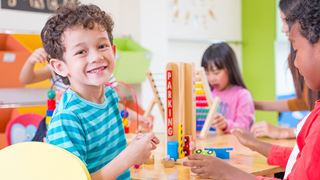How to Deal With Bullying in Schools as a Teacher
Bullies and bullying can loom large in the lives of children of all ages, bringing down the self-esteem and self-worth of their victims and instilling an environment of fear, leaving children unable to thrive.
As a teacher, it can be hard to know how and when to intervene. Mishandling a case of bullying can often make things worse for the victim or target, leading to reactions of intensified bullying or ostracisation from the victim’s peers.
As such, resolving cases of bullying requires tact and diplomacy, not only protecting the target but also helping the bully to learn and to change. Very few cases of bullying require official safeguarding intervention, but as a teacher you should be aware of how cases of bullying can escalate and why they need to be identified and stopped as soon as possible.
In this article, we explore how to identify cases of bullying in schools and the best way for teachers to respond to handle the situation and prevent further harm.
What Are Signs of Bullying at School?
Bullies will often make an effort to ensure that the abuse they give their victims happens out of sight of teachers or other adults that might tell them off. Therefore, it can be difficult to actively notice cases of bullying at school, as the students involved are less likely to act when a teacher is present.
However, there are other signs of bullying that pupils may show when teachers are around, which often indicate that something serious is going on. These include:
- A pupil appearing reluctant to come to school: arriving late or making a fuss when they are dropped off, especially after the weekend
- A pupil appearing to leave school later than other students, usually to avoid having to walk home with the bully or bullies
- A pupil changing how they travel to school, such as avoiding the bus or train
- A change in a pupil’s performance at school
- A pupil appearing increasingly tired, distracted or withdrawn
- A pupil seeming to lose their appetite or starting to skip lunch
- An increase in the days that a pupil has off sick
- A pupil appearing more isolated or stopping spending time with their friends whilst at school
- A pupil frequently being joked about by other students
- A pupil seizing opportunities to stay indoors at break and lunchtimes, such as offering to help tidy up
- Damage to a pupils possessions
- A pupil reporting that their possessions are going missing
- Physical signs of bullying such as bruises, grazes or bumps
Cyberbullying is also an increasing problem for pupils, although this kind of behaviour tends to take place outside of school and there might not ever be any in-person abuse. However, teachers may notice the signs of cyberbullying, such as:
- A pupil appearing reluctant to use computers or devices as part of in-school activities
- A pupil seeming to avoid using their phone
- A pupil appearing upset or distracted whilst on or after using their phone
- A pupil appearing reluctant to talk about their online activity
- Jokes from other students about a pupil’s online presence or activity
When it comes to how to deal with bullying at school, knowing the subtle signs of bullying is a key way for teachers to identify pupils that might be being targeted and intervene before the bullying behaviour escalates. Whilst some pupils may eventually tell a teacher that they are the victim of bullying in school, often this behaviour can go unreported for a very long time, resulting in lasting harm.
How Does Bullying Affect Children in School?
Bullying can have a massive impact on children that experience it whilst in school, both in terms of their academic performance and their physical and mental wellbeing.
Schools are supposed to be safe places for children to come to learn and interact with their peers, and bullying can stop pupils from feeling safe. This can have a significant impact on their ability to learn, which may slow their academic progression and make it harder for them to do well at school both in the present and in the future.
School bullying also often isolates the victim, which may stop them from making friends or having healthy interactions with their peers. If this happens at a young age, it may impact the child’s ability to form relationships and have social interactions as they grow up, which can lead to a range of other problems.
Research from Kings College London found that the physical and psychological impact of bullying was still felt in victims forty years after it had taken place. An increased likelihood of physical and psychological health was identified as being linked to childhood bullying, along with a great risk of mental health conditions like anxiety and depression.
In addition to the points made above about the academic and social impact of bullying in schools, the study also found that people that had been bullied were less likely to be in a romantic relationship and generally reported a “lower quality of life and life satisfaction”.
The long-lasting impact of being bullied demonstrates the importance of dealing with bullying as a teacher and why it’s necessary in stopping pupils from suffering a range of negative outcomes because of this behaviour.
How to Help a Child Being Bullied at School
Knowing how to deal with bullying at school involves understanding the best way to intervene in a situation and offer support to children that are being targeted. Here’s how you can help bullying victims as a teacher.
Show Willingness to Listen
Firstly, make sure that students know that they can come to you if something is happening to them at school that they are unhappy about. It’s very hard for pupils to speak up about being bullied, but they’ll be more likely to do so if you demonstrate a willingness to listen and tell everyone that cases of bullying will always be dealt with.
You should speak about your school’s anti-bullying policy and let students know that they should talk to you or another trusted teacher if there’s anything they’re worried about. Make sure that all students know that they should report bullying behaviour, even if they’re not directly involved, and make an effort to give your pupils opportunities to speak to you about what’s on their mind.
Take Every Report Seriously
Another important approach to dealing with bullying as a teacher is to always take reports seriously. Pupils need to see that bullying has severe consequences in school, and therefore you need to respond to any mention of bullying with a proper investigation and show your students that they will always be believed if they come to you with a report of bullying behaviour.
Sometimes, reports of bullying from pupils may be overstated or the behaviour in question is actually just the product of a falling out and can be quickly resolved. However, when bullying is treated as a serious issue, pupils will be less likely to pick on one another and more likely to mention any bad behaviour when it happens
Act Immediately
Acting immediately is another key way that you can help a child being bullied at school. If you suspect bullying or are told that bullying is taking place, don’t wait until you have more evidence or to see if it happens again. Take action immediately by speaking to the children involved or talking to another teacher to start an investigation or confirm your worries.
If you encounter bullying in the school environment, act immediately. Set yourself up between the bullied pupil and their bully and de-escalate the situation.
Once you’ve calmed the disruption, talk to the bullied pupil and the bully separately on separate occasions; this provides a safe space for the bullied pupil to talk safely and securely without having to face their tormentor. When you talk with the bully, be sure to let them know that their actions constitute bullying and will not be tolerated.
Administer punishment that is fair, but focuses on teaching the bully that what they did was wrong, rather than punishing for punishment’s sake.
Taking immediate action is important because, if a child is being bullied, it ensures that the abuse is stopped as soon as possible and the potential harm done to the child is minimised. Sometimes intervention from teachers isn’t enough to stop bullying immediately, but it can make a difference in helping the affected pupil feel less alone until the situation is resolved.
Give Pupils Autonomy
It can be tempting to step in and stop bullying yourself as a teacher, but it’s important to remember that one of the best ways to help with bullying is to ask the targeted pupil what they want to happen. Many children and young people are fearful of what a bully might do if an adult finds out about their behaviour, and whilst intervention is usually the way forward, you should consider how the victim would like the situation to be handled.
Allowing pupils to share how they would like the bullying to be dealt with gives them more autonomy and can help with confidence, both of which are important if they have been targeted and teased by other students. It can also lessen their fears about the consequences of what has happened, decreasing the overall trauma of the situation.
How to Stop Bullying at School
Along with dealing with school bullying in individual cases, teachers should also play a part in preventing bullying from taking place in the wider school environment.
Administer Firm Punishments
One of the most important approaches to remember is to ensure that bullying behaviour has consequences and will be punished appropriately. Pupils won’t be deterred from bad behaviour if they’re not worried about the consequences, so be sure that all cases of bullying are taken very seriously and dealt with fairly.
When you hand out penalties for their bullying, make sure those consequences teach the bully to change their ways rather than punish them for their behaviour.
Establish an Anti-Bullying Policy at School
Developing an anti-bullying environment in your school calls attention to it and encourages a counter-movement of talking and open discussion of bullying and its consequences. This brings all bullying to light and allows you to deal with it more easily.
It also makes it easier for other pupils to support the bullied pupil and to challenge the bully over their behaviour, potentially leading the bully to reconsider their actions and focus on self-improvement. A bullying policy in school also outlines the procedure for dealing with and punishing bullies, so all students will be aware of the potential consequences of abusive behaviour.
Offer Additional Support
As we’ve discussed, the impact of bullying can be incredibly long-lasting and it’s important to provide support to victims for a while after the incident has been resolved. This might just involve checking in with them and ensuring they are spending time with other students, but could also require intervention from school counselling services if necessary.
Sometimes, bullying in school can be stopped by working with bullies and helping them to understand the impact of their behaviour and why it was wrong. In young children particularly, bullies don’t have the social skills that allow them to solve problems without aggression. This can be taught by focusing on developing empathy and emotional intelligence, and by letting the bully know that you believe that they can change.
FAQs
Why does bullying happen?
Bullying can be motivated by a wide variety of different reasons and usually happens because a bully feels that they have a right to abuse someone else. This might be because of someone’s identity, a particular trait or something that happened, or might just happen because a bully feels the need to hurt and victimise other people.
Even if bullying behaviour is motivated by a bully’s own insecurities or unhappiness, bullying behaviour is never acceptable. There are many reasons why bullying might take place, but it is never the fault of the victim and should always have consequences.
What constitutes bullying at school?
Whilst there is no legal definition of bullying, the UK government describes it as “behaviour that is repeated, intended to hurt someone either physically or emotionally and often aimed at certain groups”. If a pupil is the target of harmful behaviour, either in person at school or online from their classmates, they are classed as being the victim of bullying.
How can school uniforms prevent bullying?
School uniforms are often cited as a method of preventing bullying because they reduce the visible differences between children which decrease the likelihood that someone will get picked on for what they’re wearing or what they look like. In a research study by Trutex, 46% of students believed that wearing a uniform reduced bullying at school and 68% believed that it made them ‘fit in’ with their peers.
Summary
Developing a stronger understanding of bullying and its consequences is the best way to understand how to prevent it in your school and among your pupils. As a teacher, you have a responsibility to keep the students at your school safe, and dealing with cases of bullying is an experience that you are likely to encounter at least once in your career.
Our comprehensive online courses on the topic and other safeguarding methods can help you increase your understanding of how to stop bullying in schools. Take a look at our range of safeguarding courses to find out more.








/safer-recruitment.jpg?mw=320&hash=A2BB5E144C89C295EC10C63680F69F39C4C3E566)




/e-safety-.jpg?mw=320&hash=A9FCF6B70F32AD3EA74633373FF0213B000F75FF)










































